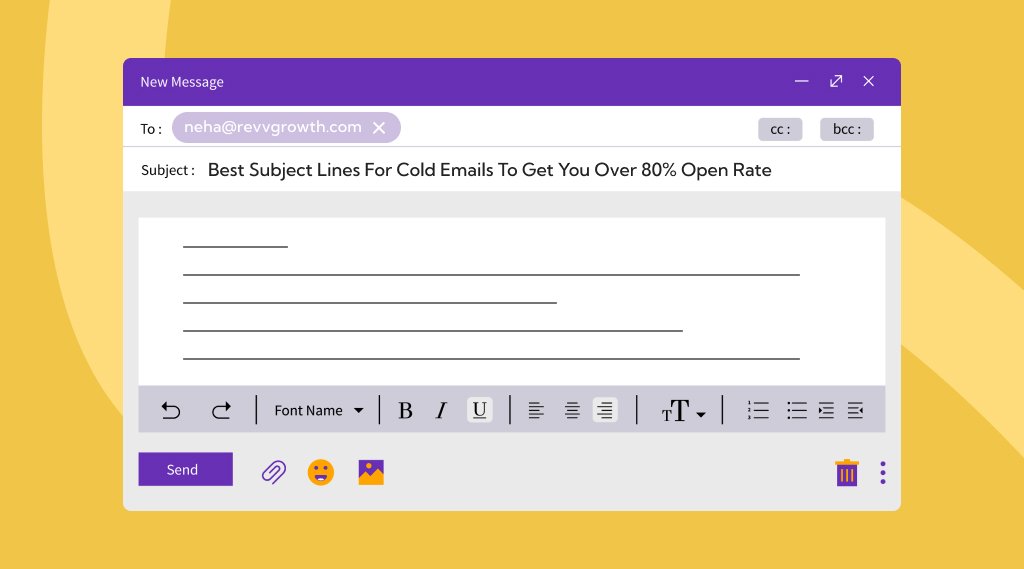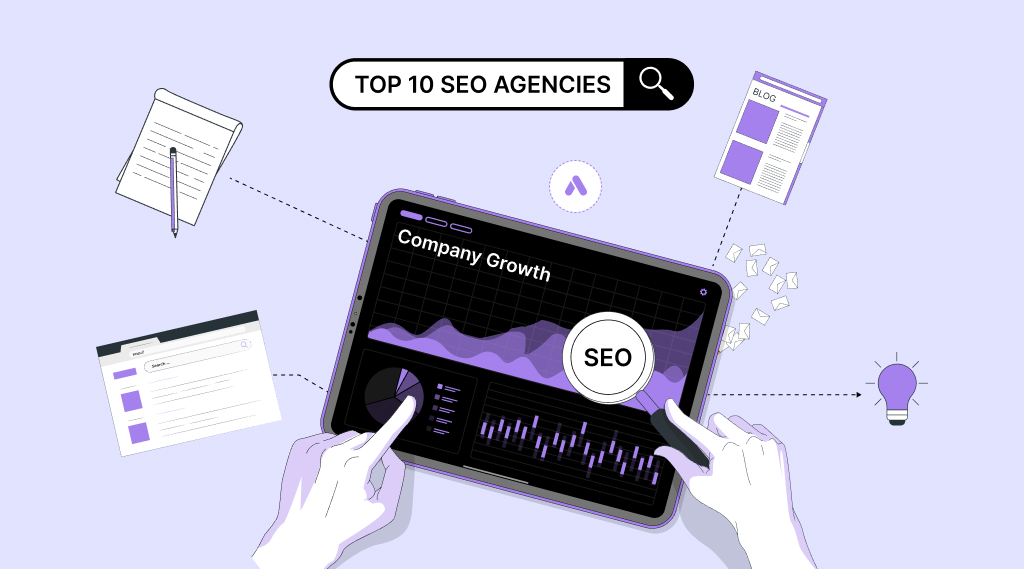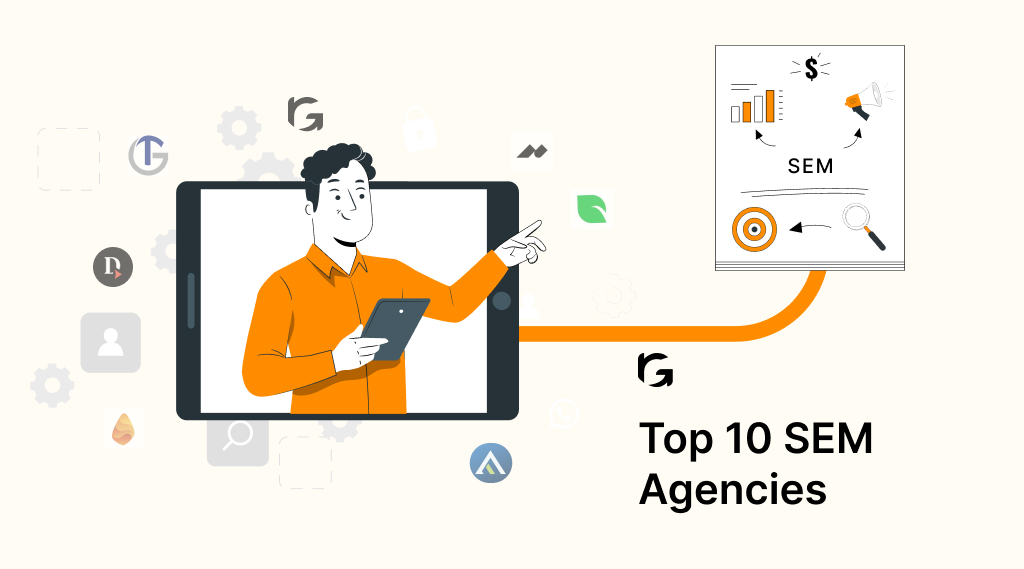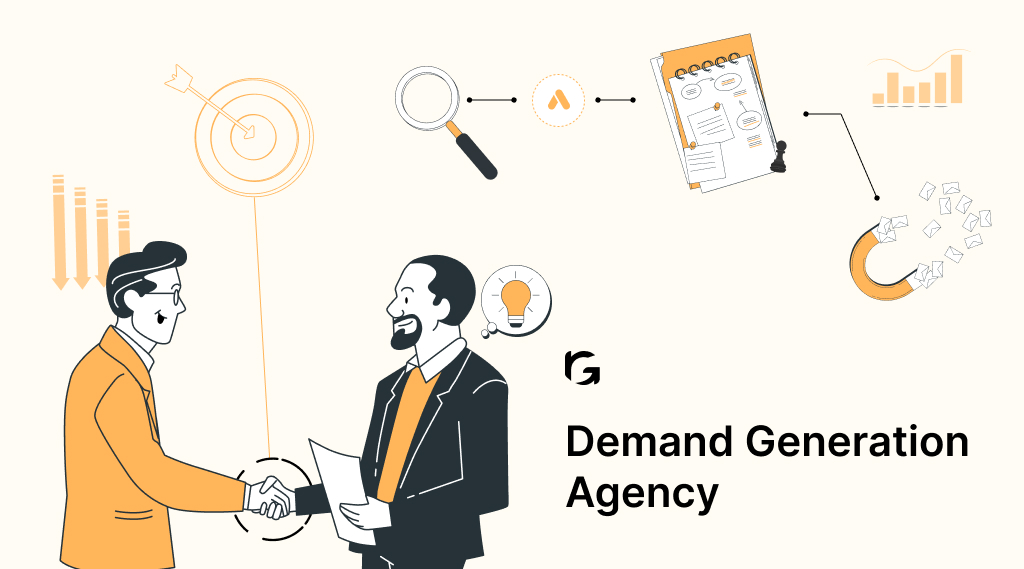Crafting strong cold email subject lines is vital for making a lasting impression and increasing engagement. Overlooking the importance of compelling subject lines could result in your emails being disregarded or flagged as spam, limiting your ability to connect with your audience effectively.
So, how to craft one? Coming up with subject lines that drive high open rates can be quite challenging, so let’s explore effective strategies to master them.
How do you write a good email subject line? 6 Tips!
Writing a good email subject line is crucial for grabbing the recipient’s attention and enticing them to open your email. With inboxes flooded with countless messages every day, a well-crafted subject line can make all the difference between your email being opened or ignored.
Here are six key factors for writing effective email subject lines:
1. Personalization
Personalizing your subject line with the recipient’s name or other relevant information can create a stronger connection and increase open rates.
When recipients see their name or personalized details, they’re more likely to perceive the email as relevant to them personally, which encourages them to open it.
2. Curiosity building
Intriguing subject lines that spark curiosity or pose a compelling question can entice recipients to open your email to satisfy their curiosity.
By hinting at valuable information or an exciting offer without giving away too much, you create a sense of anticipation that motivates recipients to click through.
3. Clarity and brevity
Clear and concise subject lines ensure that recipients understand the purpose of your email at a glance, reducing the risk of confusion or misunderstanding.
By keeping your subject lines brief and to the point, you make it easier for recipients to quickly assess whether the email is relevant to them, increasing the likelihood of them opening it.
4. Urgency and FOMO (Fear of Missing Out)
Subject lines that convey urgency or scarcity, such as Limited Time Offer or Act Now, trigger recipients’ fear of missing out (FOMO) and prompt them to take immediate action.
By creating a sense of urgency, you motivate recipients to prioritize opening your email and engaging with its content before it’s too late.
5. Relevance and segmentation
Tailoring subject lines to match the interests, needs, or preferences of specific audience segments increases their relevance and resonance.
By segmenting your email list based on demographics, behaviors, or past interactions, you can create subject lines that speak directly to each segment’s unique characteristics, maximizing engagement and response rates.
6. A/B testing and analytics
Conducting A/B testing on different subject lines allows you to identify which approaches resonate best with your audience and drive higher open rates.
By analyzing key metrics such as open rates, click-through rates, and conversions, you gain insights into what tactics are most effective and can refine your subject line strategies accordingly, optimizing the performance of your email campaigns over time.
30 Best cold email subject lines for higher open rates
Crafting effective cold email subject lines can significantly impact open rates and engagement. While there’s no one-size-fits-all solution, here’s a diverse list of 30 best-in-class cold email subject lines that have been known to garner higher open rates:
- Quick question about [specific industry/topic]
- Personalized recommendation for [recipient’s business/interest]
- [Recipient’s Company] + [Your Company]: A Winning Partnership?
- Ideas to [benefit] [Recipient’s Company]
- [Recipient’s Name], I found you through [mutual connection]
- Can we chat for a few minutes?
- [Your Company] insights for [Recipient’s Industry]
- Exclusive offer for [Recipient’s Company]
- A special invitation for [Recipient’s Name]
- Interested in boosting [specific metric] at [Recipient’s Company]?
- How [Your Company] can help [Recipient’s Company] succeed
- Quick solution for [Recipient’s Pain Point]
- Let’s discuss your [specific challenge]
- Have you considered [specific strategy/tactic] for [Recipient’s Company]?
- Your competitors are using [strategy/tactic]. Shouldn’t you?
- Idea for [specific project/initiative] at [Recipient’s Company]
- [Recipient’s Name], your expertise is needed
- Free resources to help [Recipient’s Company] grow
- Elevate your [specific aspect] with [Your Company]
- Time-saving tips for [Recipient’s Industry]
- [Your Company]’s solution for [Recipient’s Pain Point]
- Customized plan to [achieve specific goal] at [Recipient’s Company]
- Discover the latest trends in [Recipient’s Industry]
- Let’s brainstorm ideas for [specific objective] at [Recipient’s Company]
- Transform your [specific process/department] with [Your Solution]
- Unlock the potential of [specific opportunity] with [Your Company]
- [Recipient’s Name], I have a suggestion for [specific improvement]
- Need help with [specific challenge]? Let’s talk.
- Special offer for [Recipient’s Company] employees
- Level up your [specific aspect] game with [Your Company]
Remember to A/B test these subject lines to determine which ones resonate best with your target audience, and always tailor them to suit the context of your cold email and the preferences of your recipients.
Best cold email subject lines: Explained with examples!
Discover why each of these subject lines is effective in a cold email setting, accompanied by a compelling example for each one:
1. Quick question about [specific industry/topic]
This subject line suggests a brief and non-intrusive inquiry, intriguing recipients and encouraging them to open the email to satisfy their curiosity.
Example: Quick question about your recent sustainability efforts: Can we talk?
2. Personalized recommendation for [recipient’s business/interest]
Personalization demonstrates that you’ve taken the time to understand the recipient’s needs or interests, making the email more relevant and compelling.
Example: Personalized recommendation for optimizing your digital marketing ROI: Tried and tested strategies inside!
3. [Recipient’s Company] + [Your Company]: A Winning Partnership?
By framing the email as a potential collaboration rather than a sales pitch, this subject line appeals to the recipient’s desire for mutually beneficial relationships.
Example: Acme Inc. + Your Company: Let’s revolutionize the industry together!
4. Ideas to [benefit] [Recipient’s Company]
Offering concrete ideas or solutions to benefit the recipient’s company upfront demonstrates value and encourages recipients to open the email to learn more.
Example: Ideas to boost productivity at XYZ Corp.: Implement these 5 strategies for immediate results!
5. [Recipient’s Name], I found you through [mutual connection]
Mentioning a mutual connection establishes credibility and rapport, making the recipient more likely to open the email out of curiosity or trust.
Example: John, I found you through Sarah Smith from Acme Corp. She spoke highly of your innovative approach to marketing!
6. Can we chat for a few minutes?
This subject line suggests a casual and low-pressure conversation, enticing recipients to open the email to see what it’s about.
Example: Can we discuss for a few minutes about your company’s growth goals? I have some ideas to share!
7. [Your Company] insights for [Recipient’s Industry]
Promising industry-specific insights positions your company as a valuable resource, providing recipients with a compelling reason to open the email.
Example: ABC Analytics: Data-driven insights for the Healthcare Industry – Stay ahead of the competition with our latest research!
8. Exclusive offer for [Recipient’s Company]
The word exclusive adds a sense of urgency and exclusivity, making the recipient feel special and increasing the appeal of the offer.
Example: Exclusive offer for XYZ Corp. employees: Unlock VIP access to our upcoming webinar series – Limited spots available!
9. A special invitation for [Recipient’s Name]
Inviting the recipient to something exclusive or personalized makes them feel valued and more likely to open the email to learn more.
Example: A special invitation for Sarah: Join industry leaders at our exclusive networking event – RSVP now to secure your spot!
10. Interested in boosting [specific metric] at [Recipient’s Company]?
By addressing a specific pain point or goal, this subject line demonstrates relevance and offers potential solutions, prompting recipients to open the email to explore further.
Example: Interested in boosting customer retention at XYZ Corp.? Discover proven strategies tailored to your business!
Certainly! Let’s continue with elaborated explanations and improved examples for the remaining cold email subject lines:
11. How [Your Company] can help [Recipient’s Company] succeed
This subject line directly addresses the recipient’s needs and positions your company as a solution provider, enticing them to open the email to learn more.
Example: How ABC Consulting can help XYZ Corp. succeed in the competitive market
12. Quick solution for [Recipient’s Pain Point]
Offering a quick solution to a known pain point demonstrates immediate value and encourages recipients to open the email for more details.
Example: Quick solution for streamlining your supply chain management process
13. Let’s discuss your [specific challenge]
By offering to address a specific challenge the recipient may be facing, this subject line shows empathy and prompts them to engage further.
Example: Let’s discuss your HR software integration challenges – We’ve got solutions!
14. Have you considered [specific strategy/tactic] for [Recipient’s Company]?
This subject line provokes thought and encourages recipients to consider new approaches or strategies for their company’s success.
Example: Have you considered implementing AI-driven customer support for XYZ Corp.?
15. Your competitors are using [strategy/tactic]. Shouldn’t you?
Highlighting competitor activity creates a sense of urgency and prompts recipients to explore how they can stay competitive.
Example: Your competitors are using predictive analytics – Shouldn’t you be leveraging this technology too?
16. Idea for [specific project/initiative] at [Recipient’s Company]
Proposing a specific idea or initiative tailored to the recipient’s company shows proactive thinking and encourages recipients to open the email to learn more.
Example: Idea for optimizing your new product launch strategy at XYZ Corp.
17. [Recipient’s Name], your expertise is needed
Flattering the recipient and implying their expertise is valued can make them more receptive to opening the email.
Example: Sarah, your expertise is needed: Join our panel discussion on industry trends
18. Free resources to help [Recipient’s Company] grow
Offering valuable resources for free demonstrates goodwill and provides a clear incentive for recipients to open the email.
Example: Free resources to help XYZ Corp. grow: Download our comprehensive marketing toolkit today!
19. Elevate your [specific aspect] with [Your Company]
Promising to elevate a specific aspect of the recipient’s business with your company’s help positions you as a valuable partner.
Example: Elevate your customer engagement with ABC Solutions: Discover our innovative CRM platform
20. Time-saving tips for [Recipient’s Industry]
Providing time-saving tips relevant to the recipient’s industry shows empathy and offers immediate value, encouraging them to open the email.
Example: Time-saving tips for streamlining operations in the retail industry
21. [Your Company]’s solution for [Recipient’s Pain Point]
Directly addressing the recipient’s pain point and offering a solution creates a compelling reason for them to open the email.
Example: Oscorp: Your solution for simplifying project management at XYZ Corp.
22. Customized plan to [achieve specific goal] at [Recipient’s Company]
Offering a customized plan tailored to help the recipient achieve a specific goal demonstrates your commitment to their success.
Example: Customized plan to increase ROI at XYZ Corp.: Let’s discuss your growth strategy
23. Discover the latest trends in [Recipient’s Industry]
Promising insights into the recipient’s industry trends positions your company as a thought leader and encourages recipients to open the email.
Example: Discover the latest trends in e-commerce: Stay ahead of the curve with our industry report
24. Let’s brainstorm ideas for [specific objective] at [Recipient’s Company]
Inviting recipients to collaborate on brainstorming ideas fosters engagement and positions you as a partner invested in their success.
Example: Let’s brainstorm ideas for improving customer loyalty at XYZ Corp.
25. Transform your [specific process/department] with [Your Solution]
Highlighting the transformative potential of your solution for a specific process or department intrigues recipients and encourages them to open the email.
Example: Transform your sales process with ABC Sales Automation: Book a demo today!
26. Unlock the potential of [specific opportunity] with [Your Company]
Emphasizing the potential benefits of a specific opportunity with your company sparks curiosity and prompts recipients to explore further.
Example: Unlock the potential of data analytics with ABC Insights: Drive actionable insights for your business
27. [Recipient’s Name], I have a suggestion for [specific improvement]
Personalizing the subject line and offering a suggestion for improvement makes recipients feel valued and prompts them to open the email.
Example: John, I have a suggestion for optimizing your customer service experience
28. Need help with [specific challenge]? Let’s talk!
Offering assistance with a specific challenge demonstrates empathy and positions you as a helpful resource.
Example: Need help with employee training challenges? Let’s talk about how we can support you.
29. Special offer for [Recipient’s Company] employees
Offering a special deal exclusively for the recipient’s company employees adds a sense of exclusivity and encourages recipients to open the email.
Example: Special offer for XYZ Corp. employees: Get 20% off our premium subscription package!
30. Level up your [specific aspect] marketing game with [Your Company]
Emphasizing the potential to elevate a specific aspect of the recipient’s business with your company’s help creates a sense of aspiration and encourages them to open the email.
Example: Level up your social media game with ABC Social: Drive engagement and conversions like never before!
In a nutshell, each subject line aims to capture the recipient’s attention, address their specific needs or pain points, and offer a clear benefit or solution.
How to ensure your cold emails avoid spam filters?
Avoiding spam filters is crucial for ensuring that your cold emails reach the intended recipients’ inboxes and have the best chance of being opened and read.
Spam filters are designed to detect and filter out unsolicited or potentially malicious emails, so it’s essential to follow best practices to ensure your cold emails are not mistakenly flagged as spam.
Here are several strategies to help you avoid spam filters:
1. Use a trusted email service provider (ESP)
Using a reputable email service provider with a good sender reputation can significantly reduce the likelihood of your emails being flagged as spam.
Choose an ESP that complies with email marketing best practices and implements measures to prevent spamming.
2. Authenticate your domain and email address
Implement email authentication protocols such as SPF (Sender Policy Framework), DKIM (DomainKeys Identified Mail), and DMARC (Domain-based Message Authentication, Reporting, and Conformance) to verify the authenticity of your domain and email address.
Authentication helps establish trust with email providers and reduces the chances of your emails being marked as spam.
3. Avoid spam trigger words and phrases
Refrain from using words, phrases, or symbols commonly associated with spam in your subject lines, email body, or sender name.
Examples include “free,” “urgent,” “limited time offer,” excessive use of exclamation marks or all-caps text, and overly promotional language. Be concise, clear, and professional in your email content to avoid triggering spam filters.
4. Personalize your emails
Personalizing your cold emails with the recipient’s name, company name, or other relevant details can help improve deliverability and engagement rates.
Avoid sending generic or mass-produced emails that appear spammy and lack personalization. Tailor your messages to the recipient’s interests, needs, and preferences to demonstrate authenticity and relevance.
5. Optimize email formatting and structure
Ensure that your emails are well-formatted and easy to read on different devices and email clients. Use a clear and concise subject line that accurately reflects the email content.
Break up the text into short paragraphs, use bullet points for lists, and include relevant images or multimedia content to enhance readability and engagement.
6. Monitor your sending reputation
Regularly monitor your email sending reputation and deliverability metrics using tools provided by your ESP or third-party email deliverability services.
Pay attention to bounce rates, spam complaints, and engagement metrics to identify and address any issues that may affect your sender reputation.
7. Provide clear opt-out options
Include a visible and easy-to-use unsubscribe link or opt-out mechanism in your emails to allow recipients to unsubscribe from future communications if they wish.
Honoring unsubscribe requests promptly can help maintain a positive sender reputation and reduce the likelihood of your emails being marked as spam.
8. Test your emails
Before sending your cold emails to a larger audience, conduct tests by sending them to yourself or a small group of trusted recipients to check for formatting issues, spam triggers, and deliverability.
Use email testing tools to analyze your emails for potential spam characteristics and make necessary adjustments before sending them out.
By following these strategies and best practices, you can increase the chances of your cold emails reaching the intended recipients’ inboxes and avoid being filtered out as spam. Remember to prioritize authenticity, relevance, and value in your email communications to build trust and engagement with your recipients.
Bottom line?
By incorporating these strategies, cold emails can become more effective in engaging recipients and driving desired actions. Whether it’s sparking curiosity, offering valuable resources, or proposing a collaborative partnership, these subject lines are designed to resonate with recipients and prompt them to open the email for further engagement.






